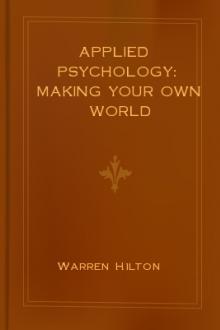Applied Psychology: Making Your Own World by Warren Hilton (easy books to read TXT) 📕

- Author: Warren Hilton
- Performer: -
Book online «Applied Psychology: Making Your Own World by Warren Hilton (easy books to read TXT) 📕». Author Warren Hilton
And you may set it down as an established principle that all states of consciousness, whether seemingly localized on the surface of the body or not, are connected with the brain as the dominant center.
The facts we have been recounting have been established by the experiments of physiological psychology. Thus, the work of the laboratory has shown that between the moment when a sense vibration reaches the body and the moment when sensation occurs a measurable interval of time intervenes.
If your eyes were to be blindfolded and your hand unexpectedly pricked with a white-hot needle, the time that would elapse before you could jerk your hand away could be readily measured in fractions of a second with appropriate instruments.
This interval is known as reaction-time. It varies greatly with different persons. During this reaction-time, the cell or cells attacked upon the surface of the hand have conveyed news of the assault through numberless intermediate sensory nerve cells to the brain. The brain in turn has sent out its mandate through the appropriate motor nerve cells to all the muscle and other cells surrounding the injured cell, commanding them to remove it from the point of danger.
The work of the nervous system in dealing with the ether vibrations that are constantly impinging upon the surface of the body has been likened to that of the transmitter, connecting wire and receiver of a telephone. Air-waves striking against the transmitter of the telephone awaken a similar vibratory movement in the transmitter itself. This movement is passed along the wire to the receiver, which vibrates responsively and imparts a corresponding wave-like motion to the air.
These air-waves when heard are what we call sound.
In the same way, air-waves striking the ear are communicated by the auditory nerve to the brain, where they awaken a corresponding sensation of sound. But these waves must be vibrating at between 30 and 20,000 times a second. If they are vibrating so slowly or so rapidly as not to come within this range, we cannot hear them.
This process is by no means a mechanical affair. On the contrary, it is a series of mental acts. Every cell in the living telegraph must receive the message and transmit it. Every cell must exercise a form of intelligence, from the auditory cell reporting a sound-wave or the skin cell reporting an injury to the muscle cells that ultimately receive and understand a message directing them to remove the part from danger.
Reaction-time, so called, is thus occupied by cellular action in the form of mental processes intervening between the nerve-ends and the brain center, in much the same way that light and sound vibrations intervene between the object perceived and the surface of the body.
For even the simplest of sense-perceptions we have, then, this sequence of events: first, the object perceived; second, the series of vibrations of ether particles intervening between the object and the body; third, the impression upon the surface of the body; fourth, the series of mental processes, cell after cell, in the nerve filaments leading to the brain; fifth, when these impressions or messages have reached the brain, a determination of what is to be done; and, sixth, a transmission by cellular action of a new message that will awaken some response in the muscular tissues.
This process is completely carried out, however, in only comparatively few instances. The vast majority of sense-impressions awaken no reaction. They are registered in the mind, but they are not perceived. We are not conscious of them. They form a part, not of consciousness, but of subconsciousness. They are messages that reach the mind but are laid aside like unopened mail because they possess no present interest.
Wherever and however you may be placed, you are always and everywhere immersed in a flood of etheric vibrations. Light, sound and tactual vibrations press upon you from every side. At a busy corner of a city street these vibrations rise to a tumultuous fortissimo; in the hush of a night upon the plains they sink to pianissimo. Yet at every moment of your day or night they are there in greater or less degree, titillating the unsleeping nerve-ends of the sensorium.
Your mind cannot take time to make all these sense-impressions the subject of conscious thought. It can trouble itself only with those that bear in some way upon your interests in life.
Your mind is like the receiving apparatus of the wireless telegraph which picks from the air those particular vibrations to which it is attuned. Your mind is selective. It is discriminating. It seizes upon those few sensory images that are related to your interests in life and thrusts them forward to be consciously perceived and acted upon. All others it diverts into a subconscious reservoir of temporary oblivion.
You will have a clearer understanding of the sense-perceptive processes and a more vital realization of the practical significance of these facts when you consider how they affect your knowledge of material things and your conception of the external world.
This subject possesses two distinct aspects.
One aspect has to do with the inability of the sense-organs to record the facts of the outer world with perfect precision. These organs are the result of untold ages of evolution, and, generally speaking, have become wonderfully efficient, but they display surprising inaccuracies. These inaccuracies are called Sensory Illusions.
The other aspect of the Sense-Perceptive Process has to do with the mental interpretation of environment.
Both these aspects are distinctly practical.
You should know something of the weaknesses and deficiencies of the sense-perceptive organs, because all your efforts at influencing other men are directed at their organs of sense.
You should understand the relationship between your mind and your environment, since they are the two principal factors in your working life.
Figure 1 shows two lines of equal length, yet the vertical line will to most persons seem longer than the horizontal one.
In Figure 2 the lines A and B are of the same length, yet the lower seems much longer.
Those things look smallest over which the eye moves with least resistance.
In Figure 3, the distance from A to B looks longer than the distance from B to C because of the time we involuntarily take to notice each dot, yet the distances are equal.
For the same reason, the hatchet line (A–B) appears longer than the unbroken line (C–D) in Figure 4, and the lines E and F appear longer than the space (G) between them, although all are of equal length.
Filled spaces look larger than empty ones because the eye unconsciously stops to look over the different parts of the filled area, and we base our estimate upon the extent of the eye movements necessary to take in the whole field. Thus the filled square in Figure 5 looks larger than the empty one, though they are of equal size.
White objects appear much larger than black ones. A white square looks larger than a black one. It is said that cattle buyers who are sometimes compelled to guess at the weight of animals have learned to discount their estimate on white animals and increase it on black ones to make allowances for the optical illusion.
The dressmaker and tailor are careful not to array stout persons in checks and plaids, but try to convey an impression of sylph-like slenderness through the use of vertical lines. On the other hand, you have doubtless noticed in recent years the checkerboard and plaid-covered boxes used by certain manufacturers of food products and others to make their packages look larger than they really are.
The advertiser who understands sensory illusions gives an impression of bigness to the picture of an article by the artful use of lines and contrasting figures. If his advertisement shows a picture of a building to which he wishes to give the impression of bigness, he adds contrasting figures such as those of tiny men and women so that the unknown may be measured by the known. If he shows a picture of a cigar, he places the cigar vertically, because he knows that it will look longer that way than if placed horizontally.
A subtle method of conveying an idea of bigness is by placing numbers on odd-shaped cards or blocks, or on any blank white space. The object or space containing the figures always appears larger than the corresponding space without the figures.
This fact has been made the basis of a psychological experiment to determine the extent to which a subject's judgment is influenced by suggestion. To perform this experiment cut bits of pasteboard into pairs of squares, circles, stars and octagons and write numbers of two figures each, say 25, 50, 34, 87, etc., upon the different pieces. Tell the subject to be tested to pick out the forms that are largest. The susceptible person who is not trained to discriminate closely will pick out of each pair the card that has the largest number upon it.
This test can be made one of a series used in examining applicants for commercial positions. It can also be used to discover the weakness of certain employees, such as buyers, secretaries and others who are entrusted with secrets and commissions requiring discretion, and who must be proof against the deceptions practiced by salesmen, promoters and others with seductive propositions.
This examination can be carried still further to test the subject's credulity or power of discrimination. What is known as the "force card" test was originally devised by a magician, but has been adopted in experimental psychology. Take a pack of cards and shuffle them loosely in the two hands, making some one card, say the ace of spades, especially prominent. The subject is told to "take a card." The suggestive influence of the proffered card will cause nine persons out of ten to pick out that particular card.
Turning from illusions of suggestion, shape and size, another field of peculiar sensory illusions is found in color aberration. Some colors look closer than others. For instance, paint an object





Comments (0)